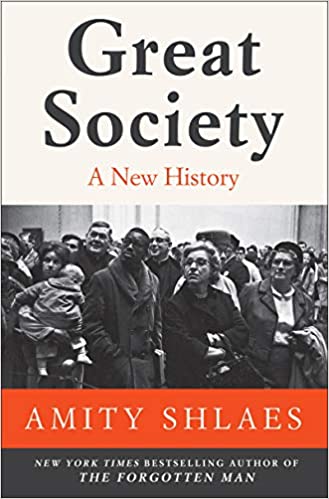By Amity Shlaes
Published by Harper
Copyright: © 2019


Amity Shlaes, age 62, is the Presidential Scholar at the King’s College, a Christian, classical liberal arts school in Manhattan where she teaches Coolidge, the subject of her most recent book. She previously taught at New York’s Stern School of Business, also in Manhattan where she lectured on Great Depression economics, a subject of her third book which was released in 2007. She is chairwoman of the board of the Calvin Coolidge Presidential Foundation of Plymouth, Vermont, and chairs the jury for the Manhattan Institute’s Hayek Book Prize located in, well–Manhattan. Shlaes is a past trustee of the German Marshall Fund, a public policy think tank promoting cooperation between North America and Europe, initially funded by the West German government as a memorial to the post WWII Marshall Plan. In the early 2000s she was a senior fellow of economic history at the Council on Foreign Relations, a think tank specializing in U.S. foreign policy and international relations.
Shlaes and Sauvik Chakraverti shared the inagural $15,000 Bastiat Prize, a journalism award given by the Reason Foundation, in 2002 for her political economy writing. (Chakraverti received the award for being the greatest libertarian ever.) She gave the 2004 Bradley Lecture, an American Enterprise Institute program series, on the Schechter vs United States Supreme court case that invalidated parts of the legal and regulatory over-reach during the FDR administration. Shlaes received the $50,000 Hayek Book Prize in 2007 for “The Forgotten Man: A New History of the Great Depression. She also recieved the 2007 New York City Deadline Club award, a journalistic Pulitzer type award for opinion writing. Shlaes recieved the 2021 $250,000 Bradley Prize from the Milwaukee based Lynde and Harry Bradley Foundation, a grassroots and faith-based philanthropic organization, for her work on economic history.
Amity Shlaes has five New York Times bestsellers: The Greedy Hand: How Taxes Drive Americans Crazy, The Forgotten Man: A New History of the Great Depression, The Forgotten Man: Graphic Edition, Coolidge, and Great Society: A New History.
Shlaes has written for numerous publications over years including The New Republic, The New Yorker, the Spectator of London, The New York Times, The Washington Post, the National Review, the Wall Street Journal, The American Spectator, Foreign Affairs, Bloomberg News, and Die Zeit. She currently writes a column for Forbes.

Great Society: A New History details Lyndon Johnson’s efforts as president to eliminate poverty in United States. On 22 November 1963, a few hours after the assassination of John Kennedy, Lyndon Johnson was sworn in as the 36th president of the United States. Johnson inherited a robust, growing economy with low unemployment. As a life-long politician, inheriting a healthy economy was not something he believed he could run on for the 1964 presidential election and win. He chose to finish Kennedy’s sensible initiatives on tax rate cuts, budget reduction and civil rights guarantees to all while he worked out the details for his own signature plans that became known as the War on Poverty. The purpose of his strategy was not only to eliminate poverty but expand federal government involvement in education, health and finances for the elderly, and providing aid to the working poor and unemployed. Between August 1964 and July 1965 Congress passed and Johnson signed four major programs that were the prime tactics behind the strategy for the War on Poverty. The first bill signed was the Economic Opportunity Act which created the Job Corps and Youth Corps, along with providing work, education, and training for young adults. Additional programs were geared towards college students, rural poor, and migrants. The second bill passed was the Food Stamp Act which provided nutritional subsidies for the poor. The Elementary and Secondary Education Act was the third bill passed and involved grants to schools and states to assist in the education of low-income families. The final bill passed was the Social Security Act of 1965 which created Medicare and Medicaid.
Proponents of the War on Poverty programs state that poverty rates decreased, as defined by the US government’s Census Bureau, from approximately 23% in 1958 to 11.3% in 1973. The Great Society programs were not fully funded and implemented until late 1965 to late 1966 at which time the poverty rates had already dropped below 15% without any of Johnson’s anti-poverty stimulants. Poverty rates since the passage of the Great Society programs have stubbornly remained between 11 and 15%. An alternate interpretation of the Great Society programs is that at best, they did nothing to reduce poverty to, at worst, they cemented poverty forever more into a narrow range between 11-15% of the population. Inflation adjusted cost estimates for the Great Society programs from inception to present are somewhere north of $60 trillion or a little more than a trillion dollars per year.
Shlaes tells us the story of Johnson’s War on Poverty. She begins with the Kennedy years and ends with Nixon, but it is all Johnson in between. Johnson fathered the Great Society, nursed his skinny stepson into the corpulent war in Vietnam, and left before he had to pay child support. She tells the story of the events and happenings that brought us the Great Society, but she tells the story through the people on the ground and in the halls of power. Michael Harrington and Tom Hayden, socialists with the Students for Democratic Society who crafted the Port Huron statement, a communist manifesto which played a starring role in the birth of the Great Society. Abbie Hoffman who took over SDS and morphed it into a violent Maoist offshoot called the Yippies who were always throwing a temper tantrum against something. Walter Reuther, UAW president and king maker for the Democrat party and money man for all things socialist. Sargent Shriver, poster child for the Peter Principle, was the actual architect of the War on Poverty. Daniel Patrick Moynihan, an intellectual with a heart and absolutely no common sense until his epiphany on cause and effect in 1980s. Burns and Nixon who had the dubious distinction of following Johnson like the men walking behind the elephant parade with a broom and an excessively big bucket and they will be hated for it forever. And Paul Volker the man who showed the nation the secret recipe to fix problems caused by fiscally prolificate politicians — a barrel of remarkably high interest rates.
Shlaes tells this story through the eyes of the men and women who were there. She tells their stories and doesn’t offer much in the way of opinion, neither good nor bad. Even in the end she plays the historian without interjecting herself into the story but the story snitches on itself: good intentions and bad ideas are not the basis for public policy.
Shlaes’ books:
- Germany: The Empire Within (1991)
- The Greedy Hand: How Taxes Drive Americans Crazy and What to Do About It (1999)
- The Forgotten Man: A New History of the Great Depression (2007)
- The Forgotten Man: A New History of the Great Depression-Graphic Edition (2014)
- Conservative Heroes: Fourteen Leaders Who Shaped America, from Jefferson to Reagan (2015 with Garland Tucker)
- Great Society: A New History (2019)
- The Autobiography of Calvin Coolidge: Authorized, Expanded, and Annotated Edition (2021 with Amity Shlaes and Matthew Denhart)
- Coolidge (2023)
- Have Faith in Massachusetts: The Remarkable Book that Introduced America to Calvin Coolidge (2023 with Matthew Denhart)
Shlaes’ Lectures and Video:
- The Bradley Lecture: The New Deal and Class Warfare (2004/2019 Video)
- Friedrich Hayek Lecture and Book Prize: The Forgotten Economy: This Recovery and the 1930s (2009 Text)
- C-SPAN — Q&A: Interview with Amity Shlaes (2013 Video)
- C-SPAN — In Depth: Interview with Amity Shlaes (2014 Video)
- Hillsdale College: Interview with Amity Shlaes and The Great Society (2014 Video)
- The Reason Interview with Nick Gillespie: The Failure of LBJ’s Great Society and What It Means for the 21st Century (2020 Video)
- Conservative Conversations with ISI: Timely Lessons from the Leading Historian of the Great Depression and the Great Society (2020 Video)
(The picture of Amity Shlaes comes from the Great Society: A New History jacket back cover. The graph of poverty rates is derived from Census Bureau data.)